INVESTIGATION OF THE HEAT AFFECTED ZONE BY THERMAL CYCLE SIMULATION TECHNIQUE
INVESTIGATION OF THE HEAT AFFECTED ZONE BY THERMAL CYCLE SIMULATION TECHNIQUE
Heat affected zone, Therman cycle simulation, Steel, Microstructures,
___
- 1. Dzidowski, E.S., and Banach, J. Working conditions and the potential damage of energy pipelines with respect to welding technology [in Polish]. Proceedings of 1-st scientific-technical conference PIRE -98, 1998, 57-62.
- 2. Abson D.J., Tkach, Y., Hadley, I., Wright, and V.S., Burdekin, F.M. A review of postweld heat treatment code exemptions. Weld J, 2006, 85: 63–69.
- 3. Gunaraj, V. and Murugan, N. Prediction of Heat affected zone characteristics in submerged arc welding of structural steel pipes. Welding research, 2002 :94-98.
- 4. Moghaddam M.A., Golmezergi R., and Kolahan F. Multi-variable measurements and optimization of GMAW parameters forAPI-X42 steel alloy using a hybrid BPNN-PSO approach. Measurement, 2016, 92: 279-287.
- 5. Samardžić I, Stoić A, Kozak D, Kladaric I, Dunđer M. Application of Weld Thermal Cycle Simulator in Manufacturing Engineering, J. of Manufac. and Indust. Eng. 2013, 12: 7–11.
- 6. Dunder M., Vuherer T., and Kladaric I. Weldability Investigation of TStE 420 after Weld Thermal Cycle Simulation, Strojarstvo, 2010, 52, 97–104.
- 7. Górka, J., Janicki, D., Fidali, M., and Jamrozik, W. Thermographic assessment of the HAZ Properties and structure of thermomechanically treated steel, Int J Thermophys,2017: 38-183.
- 8. Dunđer, M., Samardžić, I., and Vuherer, T. Weldability Investigation Steel P91 by Weld Thermal Cycle Simulation, Metalurgija, 2015, 54: 539–542.
- 9. Boumerzoug, Z., and Cherif, S. (2017), Thermal cycle simulation of welding process in Inc 738 LC superalloy, K. Eng. mater.,2017, 735: 75-79.
- 10. Raouache, E., Boumerzoug, Z., Delaunois; F., and Khalfallah, F. Investigation by Thermal Cycle Simulation of Heat Affected Zone in Welded AA2014 Aluminum Alloy. Res Dev Material Sci. 2020, 13(3). RDMS.000812.
- 11. Hamdi, I, Boumerzoug, Z., and Delaunois, F., Simulation of Heat Affected Zone in X60 Steel , Insights Min Sci technol., 2020, 2(2): 52-57.
- 12. Łomozik, M. The effect of repeated thermal cycles of welding on the plastic properties and structure of the heat affected zone of 13HMF steel after the operation longer than 130,000 hours [in Polish], Energetyka, 2007,Thematic Issue 14: 64-68.
- 13. Łomozik, M. Microscopic analysis of the influence of multiple thermal cycles of welding on breaking work and hardness of the simulated HAZ zone for P91 steel [in Polish], Energetyka, 2008,Thematic Issue 18, 68-71.
- 14. Śloderbach, Z. and Pająk, J. determination of ranges of components of heat affected zone including changes of structure, Archives of Metallurgy and Materials, 2015, 60, I 4.
- Yayın Aralığı: Yılda 2 Sayı
- Başlangıç: 2018
- Yayıncı: Necip Fazıl YILMAZ
RESEARCH ON THE ELECTRICAL EFFECT OF FERROMAGNETIC MATERIAL ON THE COIL
Mehmet Ali ÖZÇELİK, Ahmet AYCAN
INVESTIGATION OF THE HEAT AFFECTED ZONE BY THERMAL CYCLE SIMULATION TECHNIQUE
Zakaria BOUMERZOUG, Fabienne DELAUNOİS, Oualid BEZİOU, Ines HAMDİ
INVESTIGATION OF EFFECT OF PRE-CONSUMER RECYCLING ACRYLIC FIBER RATIO ON YARN AND FABRIC PROPERTIES
Esin SARIOĞLU, Serdar SAYCAN, Perihan TEKİN, Halil İbrahim ÇELİK, Hatice Kübra KAYNAK
A COMPARATIVE STUDY OF BRAKE WEAR PERFORMANCE WITH RECENT COATING METHODS
Recep AKYÜZ, Ekrem ALTUNCU, Çiğdem DİNDAR, Hakan AYDIN
FABRICATION AND WELDING OF ALUMINUM COMPOSITE
Wafa MELİK, Zakaria BOUMERZOUG, Fabienne DELAUNOİS
Ömer EYERCİOĞLU, Engin TEK, Mehmet ALADAĞ
Altuğ UŞUN, Recep GÜMRÜK, Nuri YILDIZ, Bahri Barış VATANDAŞ
Ufuoma UNUEROH, Amos Omoefe EBEBEİNWE
YARN QUALITY INVESTIGATION OF COMPACT COTTON YARNS WITH DIFFERENT COMBING NOIL PERCENTAGE
